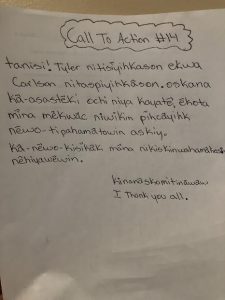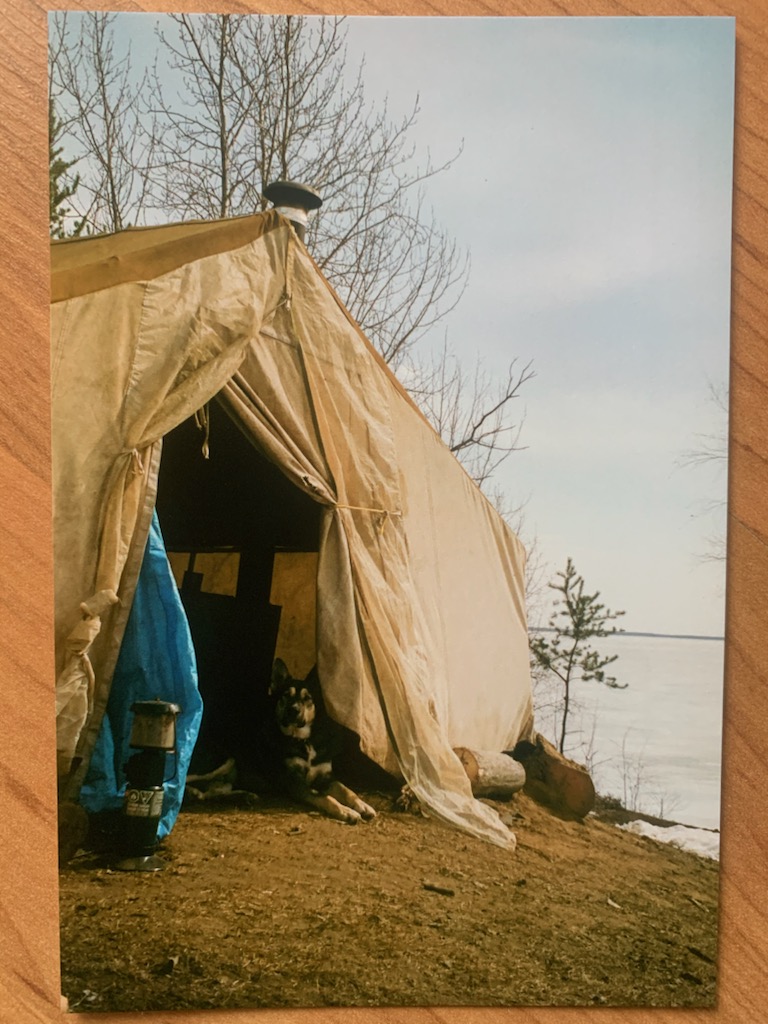A glance into my journey towards reconciliation begins in the early stages of my life and how I was subject to some of the beauty the Indigenous culture holds through exploration of my outdoor pursuits. I readily admit that in these reflections, my young and undeveloped mind was not engaged in the hardships that this culture has extensively undergone, and continues to endure on the behalf of the Indian Residentials Schools that once operated. It is important for me to acknowledge that I have lived in a system that favors the dominant culture, being white has led me to realize how easy I have had it.
My introduction to a genuine interest of learning about Truth and Reconciliation, stemmed from working inside the community of North Central Regina. I was fortunate enough to witness a knowledge keeper come into the building I was working at and teach some of the grade seven and eights some nêhiyawêwin, which is the Cree word for Cree language/speaking, and at this point I began digging more into nêhiyawêwin, as I was quite fond of this individual and the beauty he shared when speaking the language. As we momentarily rewind history, it is important to acknowledge how vital language is to Indigenous culture in shaping and fostering identity, in this case I relate it to what I have learned over the last two years, regarding the Residential School systems effect on traditional Indigenous languages, we must understand that one of the Canadian government’s main focuses was to remove languages from Indigenous peoples in the name of colonial oppression. As stated in, Final Report of the Truth and Reconciliation Commission of Canada, I paid a lot of attention to this quote on behalf of the Canadian Government, “Government officials also were insistent that children be discouraged–and often prohibited—from speaking their own languages. (Lormier, 2015, p.4); As I further myself on my journey to reconciliation, I ponder, how can the implications of the past further illuminate my goals of becoming a future educator?
I have chosen to create my aesthetic representation in a different form of art, in which I present as learning the language. Call to action #14, (Lormier, 2015, p.320), in the TRC book published in 2015 directly focuses attention on “Language and Culture”, and after hearing many stories of how language was forbidden in many schools of the past I realized how important this particular call was. I wondered how I may be able to apply myself further in relation to this form of reconciliation as an aspiring educator, and as stated in this call; “The federal government has a responsibility to provide sufficient funds for Aboriginal-language revitalization and preservation” (Lormier, 2015, p.321). A small step in my personal journey reflects on my contribution to learning as much Cree as I can.
Here I have begun working on a sentence, with knowledge and insight I have acquired by attending Cree language classes at First Nations University of Regina, attending workshops with Reconciliation Regina and some self study, with respect to Indigenous leadership and consultation. I am proud to say that I will continue to add more to this sentence, as I continue to progress towards learning more about the language.

It starts for me with an interest in linguistics, and how I can apply that focus into my journey as an educator, advocating myself as an ally to Indigenous communities by promoting the language inside the schools in which I will work , specifically related to nêhiyawêwin, what applying what I’ve been taught in avenues which seem fit. I will never know what exactly it feels like to have something as important as language to be removed from my culture and how that may make generations of peoples feel, this demonstrates the privileges I have had growing up as a white settler. As the awful history of colonial oppression has torn apart the Indigenous languages that used to be widely spoken across the province of Saskatchewan, I was introduced to the Indigenous speaker Joseph Naytowhow, as a result, I really began to appreciate individuals like him, with their ability to capture listeners attention by the way he spoke nêhiyawêw. A direct quote that inspired me from Joseph reads; “we must first teach the kids to listen” (Naytowhow, 2021, 0:06). This was followed by Joseph translating a few more words in Cree, a way in which I really appreciated the merit and importance of hearing a traditional Cree speaker talking in an Indigenous language, notably one that the government attempted to remove, reinforcing the idea of perseverance that many Indigenous people can proudly say they have. I connected this quote back to some of the first times I heard Cree being spoken, considering how powerful it was to me, it led me to realize that I can only wonder what it could feel like for Indigenous and Non-Indigenous youth to hear inside of the school systems that exist today, promoting respect and making improvements to the atrocities of the past. I paid close attention to the importances and exploration of Indigenous oral storytelling, traditions, and language in relation to Indigenous culture realizing how powerful it is to hear, I can pinpoint moments like this in Naytowhow’s Teach The Kids into my inspiration of furthering myself towards learning more about the Cree language, as I continually try work on myself and my contribution to revitalizing the language in as some of my steps to reconcile.
Furthermore, it also starts with having a very open minded approach and compassionate heart when beginning to conceptualize how the colonial powers harmed the Indigenous population. I found myself in a moment of silence after hearing George Couchie speak in the video Cultural Mindfulness, a video that I will refer back to many times in my future. I began to think of people who live in our city, some are more fortunate than others, some are homeless, some are alcoholics and some have mental health complications. I tried to connect some of the realities of these situations to the ways in which racism, oppression, and governmental influence has directed people to be in these places. As stated by Couchie, “When you meet someone for the first time, you’re going to meet two people, the person you can see and the one you can not, everyone has a story, one you see and then one you do not” (Couchie, 2019, 1:56). I felt this statement hit home for me, as I have grown up with such privilege in the society we all live in, while being part of a society of some people who did not, allowing me to understand that everyone’s story is different then mine. The impact of these Residential Schools has left generations of families out of touch with their authentic cultures, ways of being and knowing, which has caused many hardships to say the least. I hope to create a space in my classroom that promotes critical thinking, that allows for students to be able to discuss the difficult realities and humanizes people that are victims of the aftermath of colonial oppression. The truth is we must have these conversations to start walking in the path of healing by listening, observing, loving and understanding what it is we Non-Indigenous people can do to work towards a common goal of Truth and Reconciliation. George mentions,“Culture is healing” (Couchie, 2019, 16:27), I feel that adapting a culturally competent lesson plan, by working together with consultation and insight from Indigenous leaders, I as a future educator can provide a positive school environment that constructs healthy learning. As a reminder from a piece I took from our ECS 101 course, I reminded myself ; “In the past, schools have been used for colonial purposes of forced assimilation.” (University of Victoria), decolonizing education is a very significant part of allowing other forms of knowledge to be promoted in our curriculum.
I recognize that there are so many elements that can aid in the long journey of reconciliation, I choose to involve myself in a way in which I can contribute my most sincere self in my ambitions of starting to actually reconcile. I choose the call to action #14, in the Final Report of the Truth and Reconciliation Commision of Canada. Revitalizing the language is something I feel I can personally challenge myself with, and further promote this very significant way of giving back by learning about this culture and language. I will spend my time listening, observing, and studying the language as I continue to reflect on what it is I need to do in my journey to be a better ally to all Indigenous peoples.
References
Couchie, G. (n.d.). Cultural mindfulness. Cultural Mindfulness. Retrieved November 21, 2022, from https://www.culturalmindfulness.ca/cultural-mindfulness
Lorimer, J., & Company Ltd., (2015). Final report of the truth and reconciliation commission of Canada: Summary of The final report of the Truth and Reconciliation Commission of Canada (Summary, Vol. One). Lorimer.
Naytowhow, J. (n.d.). Teach the kids. Joseph Naytowhow. Retrieved November 21, 2022, from https://josephnaytowhow.com/storyteller/teach-the-kids/
University of Victoria. (n.d.). Decolonizing Education. arch-brief.pdf. Retrieved November 13, 2022, https://www.uvic.ca/research/centres/youthsociety/assets/docs/briefs/decolonizing- education
Ratt, S., & Martin, H. (2021). Mâci-nêhiyawêwin = beginning Cree. University of Regina Press.
Wolvengrey, A. (n.d.). Itwêwina: The Online Cree Dictionary. Plains Cree dictionary. Retrieved November 16, 2022, from https://itwewina.altlab.app/

